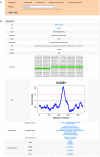PrionScan: an online database of predicted prion domains in complete proteomes
- PMID: 24498877
- PMCID: PMC3922584
- DOI: 10.1186/1471-2164-15-102
PrionScan: an online database of predicted prion domains in complete proteomes
Abstract
Background: Prions are a particular type of amyloids related to a large variety of important processes in cells, but also responsible for serious diseases in mammals and humans. The number of experimentally characterized prions is still low and corresponds to a handful of examples in microorganisms and mammals. Prion aggregation is mediated by specific protein domains with a remarkable compositional bias towards glutamine/asparagine and against charged residues and prolines. These compositional features have been used to predict new prion proteins in the genomes of different organisms. Despite these efforts, there are only a few available data sources containing prion predictions at a genomic scale.
Description: Here we present PrionScan, a new database of predicted prion-like domains in complete proteomes. We have previously developed a predictive methodology to identify and score prionogenic stretches in protein sequences. In the present work, we exploit this approach to scan all the protein sequences in public databases and compile a repository containing relevant information of proteins bearing prion-like domains. The database is updated regularly alongside UniprotKB and in its present version contains approximately 28000 predictions in proteins from different functional categories in more than 3200 organisms from all the taxonomic subdivisions. PrionScan can be used in two different ways: database query and analysis of protein sequences submitted by the users. In the first mode, simple queries allow to retrieve a detailed description of the properties of a defined protein. Queries can also be combined to generate more complex and specific searching patterns. In the second mode, users can submit and analyze their own sequences.
Conclusions: It is expected that this database would provide relevant insights on prion functions and regulation from a genome-wide perspective, allowing researches performing cross-species prion biology studies. Our database might also be useful for guiding experimentalists in the identification of new candidates for further experimental characterization.
Figures





References
-
- Shorter J, Lindquist S. Prions as adaptive conduits of memory and inheritance. Nat Rev Genet. 2005;6(6):435–450. - PubMed
Publication types
MeSH terms
Substances
LinkOut - more resources
Full Text Sources
Other Literature Sources

